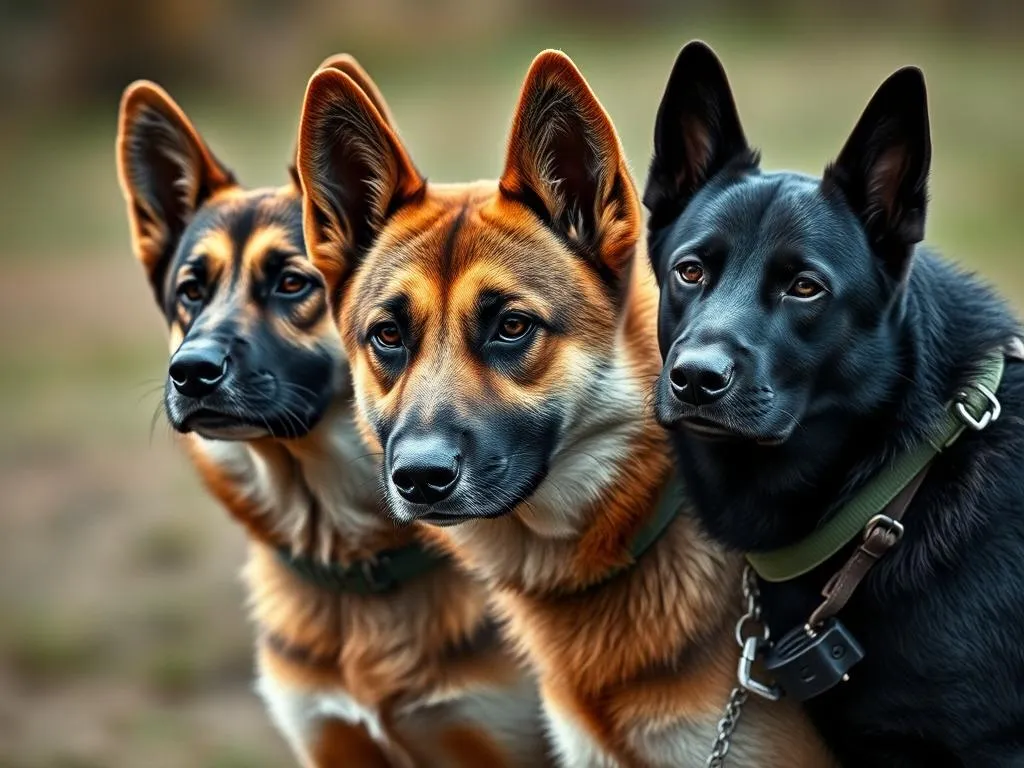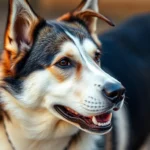
Military dog breeds play a critical role in the safety and effectiveness of military operations globally. These dogs are bred and trained to assist in various capacities, from detection and patrol to search and rescue. Their contributions are invaluable and often life-saving, showcasing the incredible bond between humans and canines.
History of Military Dogs
Early Use of Dogs in Warfare
Military dog breeds have a rich history that dates back to ancient civilizations. Dogs were used by the Greeks, Romans, and Egyptians in warfare. For instance, the Roman army utilized large breeds, such as the Molossian hound, to intimidate enemies and protect their soldiers. In medieval times, dogs were often employed as sentries to guard encampments, and their keen sense of smell and hearing made them essential companions in battle.
Evolution Over Time
As warfare evolved, so did the roles of dogs. In World War I, dogs were officially recognized for their contributions, serving as messengers, sentries, and even in medical roles. By World War II, the use of dogs became more sophisticated, with specific breeds being trained for specialized tasks. The military began to see dogs not just as companions but as essential assets in combat and reconnaissance.
Key Milestones
Significant events underscore the pivotal role of military dog breeds. For example, during the Vietnam War, dogs were used extensively for patrol, detection of explosives, and even tunnel searches. These brave canines often worked in dangerous conditions, showcasing their loyalty and courage.
Characteristics of Military Dog Breeds
Physical Attributes
Military dog breeds are typically selected for their physical capabilities. Most breeds used in military operations possess strong builds, agility, and endurance. Size can vary, but many of the most common breeds fall within the medium to large category, ensuring they can perform demanding tasks such as carrying equipment or navigating challenging terrains.
Temperament Traits
The temperament of a military dog is just as important as its physical attributes. Key characteristics include:
- Intelligence: Military dogs must quickly learn commands and tasks.
- Obedience: They need to respond to commands without hesitation.
- Trainability: A high capacity for learning is essential, as they undergo extensive training.
These traits ensure that military dogs can function effectively in high-pressure environments.
Health Considerations
Like all dogs, military dog breeds are prone to certain health issues. Common problems may include hip dysplasia, skin conditions, and obesity. Regular veterinary care, a balanced diet, and adequate exercise are vital for maintaining their health and performance.
Types of Military Dog Breeds
Detection Dogs
Detection dogs are trained to sniff out explosives, drugs, and even human remains. Breeds commonly used for these tasks include:
- German Shepherds: Renowned for their intelligence and versatility.
- Belgian Malinois: Favored for their agility and keen sense of smell.
These dogs undergo rigorous training to enhance their scent detection capabilities, often participating in life-saving missions.
Patrol Dogs
Patrol dogs are essential for maintaining security and controlling areas. Breeds well-suited for patrol duties include:
- Rottweilers: Known for their strength and protective instincts.
- Doberman Pinschers: Agile and intelligent, making them excellent patrol companions.
These dogs are trained to assess environments, deter threats, and protect military personnel.
Search and Rescue Dogs
Search and rescue operations can be critical during natural disasters or military operations. Breeds effective in this role include:
- Labrador Retrievers: Friendly and eager to please, they excel in locating missing persons.
- Golden Retrievers: Known for their excellent temperament and trainability.
These dogs are trained to work in various terrains and conditions, demonstrating remarkable resilience.
Attack and Protection Dogs
Attack and protection dogs are specifically trained to defend military personnel. Breeds like the Belgian Tervuren are known for their agility and loyalty. Training methods often involve:
- Aggression Control: Ensuring dogs can be aggressive when necessary but also calm on command.
- Situational Awareness: Teaching dogs to assess threats and react appropriately.
These dogs are crucial for personal protection in high-risk situations.
Training Military Dogs
Overview of Training Processes
Training is a cornerstone of preparing military dog breeds for their roles. The training process typically begins with basic obedience and progresses to specialized skills.
Basic Obedience Training
Basic obedience training establishes a foundation for all future tasks. Key commands include:
- Sit
- Stay
- Come
These commands are essential for ensuring safety and control in various environments.
Specialized Skills Training
Once basic obedience is mastered, dogs undergo specialized skills training tailored to their roles. For detection dogs, this may involve scent recognition exercises, while patrol dogs might practice tracking and area control techniques.
Role of Handlers
The bond between military dogs and their handlers is vital. Handlers are responsible for training, caring for, and working alongside the dogs in the field. This relationship is built on trust and communication, enhancing the effectiveness of both the dog and the handler during operations.
Notable Military Dog Breeds
German Shepherd
The German Shepherd is perhaps the most recognized of the military dog breeds. Known for their intelligence and versatility, these dogs have been used in various roles, from detection to protection. Their loyalty and ability to learn complex tasks make them a staple in military operations worldwide.
Belgian Malinois
The Belgian Malinois has gained prominence in recent years, especially in special operations. Their agility and keen senses make them ideal for detection and patrol duties. With a high energy level, they require extensive training and exercise, ensuring they remain sharp and effective.
Labrador Retriever
Labrador Retrievers are often employed in detection and search and rescue roles due to their friendly nature and strong work ethic. They excel in locating explosives and missing persons, showcasing their intelligence and adaptability in various scenarios.
Rottweiler
Rottweilers are formidable protection dogs. Their strength and courage make them excellent for patrol duties, while their loyalty to their handlers is unmatched. Training for Rottweilers focuses on obedience and situational awareness, ensuring they can effectively protect military personnel.
Doberman Pinscher
The Doberman Pinscher is a breed known for its intelligence and speed. Historically used in military applications, they remain popular for their ability to patrol and protect. Their strong instincts and trainability make them valuable assets in high-stress environments.
The Impact of Military Dogs
Contributions to Military Operations
Military dog breeds have demonstrated their value in countless operations. For example, during the Iraq War, detection dogs played a crucial role in identifying explosives, significantly enhancing the safety of troops. Their ability to work in dangerous conditions has led to numerous successful missions.
Recognition and Awards
Military dogs often receive recognition for their bravery. Awards and medals, such as the PDSA Dickin Medal, have been awarded to dogs for their exceptional service. These honors highlight the vital role of dogs in protecting lives and contributing to military success.
Post-Service Life
After their service, many military dogs are retired and transitioned to civilian life. Organizations often facilitate adoption programs, ensuring these loyal companions find loving homes. Their post-service lives can be fulfilling, allowing them to enjoy a well-deserved rest after years of dedicated service.
Conclusion
Military dog breeds have a profound impact on military operations, showcasing their loyalty, intelligence, and bravery. The evolution of their roles highlights the ongoing importance of these animals in modern warfare. As military technology advances, the future of military dogs remains bright, with continued innovations in training and operational roles.
In appreciating the contributions of military dogs, it’s essential to recognize the bond they share with their handlers and the profound impact they have on the safety and success of military missions. Understanding these remarkable animals helps foster respect and support for their roles in our armed forces.
FAQs
What breeds are considered military dog breeds?
Common military dog breeds include German Shepherds, Belgian Malinois, Labrador Retrievers, Rottweilers, and Doberman Pinschers, among others.
How are military dogs trained?
Military dogs undergo extensive training that includes basic obedience, specialized skills training, and developing a strong bond with their handlers.
What roles do military dogs perform?
Military dogs perform a variety of roles, including detection of explosives and drugs, patrol duties, search and rescue missions, and protection tasks.
What happens to military dogs after they retire?
After retirement, many military dogs are adopted into civilian homes, often facilitated by organizations dedicated to their care and rehoming.
Are military dogs recognized for their service?
Yes, military dogs can receive honors and awards for their service, including medals like the PDSA Dickin Medal for exceptional bravery.









